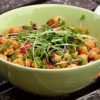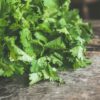This recipe comes to us from 2019 Hazon Food Conference Presenter Miche Bacher. My tag line, “eat pretty”, is not just about how beautiful flowers are and how pretty your plates are when you include flowers in your food, it is a metaphor for the way edible flowers can help us take care of the earth. The flowers we choose to eat are grown organically and are just as enticing to our pollinator friends as they are to us. Fresh flower season is short, so make sure to take full advantage by “putting up” your bounty. Make your vinegars, oils, sugars, chutneys, and alcoholic infusions, and don’t forget to share with friends and family! I love chutney! Really, really, love chutney. It is so underutilized and has incredible potential. I make chutneys all summer long using fresh summer fruits and flowers and through fall and winter with frozen blackberries and dried hibiscus. What do flowers add? Well – they add that “what’s in this?” factor, some health benefits, and a pinch of extra yummm…Don’t have the specific fruit in this recipe? Or the right flower sugar? It’s ok – mix and match, find what you like, the technique is the […]
Topic: Food Conference
Recipe: Sutlach (Cream of Rice Pudding)
This recipe comes to us from 2019 Hazon Food Conference Presenter Susan Barocas. A creamy, delicate pudding, sutlach (in Turkish sütlaҫ or mahallebi) is traditionally served to break the fast after Yom Kippur and for Shabbat morning breakfast, although it is a beloved treat any time. The pudding is prepared with milk or pipitada, a drink made by steeping dried and ground cantaloupe seeds in water for 24 hours. This drink is said to be especially restorative following the fast. Instead of vanilla and orange zest, you can use 2 tablespoons rose water for a different flavor. Many people fondly remember mothers or grandmothers sprinkling cinnamon in the shape of their initials on the top of individual servings. Recipe from Sephardic Flavors: Jewish Cooking of the Mediterranean by Joyce Goldstein. Ingredients 6 tbsp rice flour or cream of rice 6 tbsp sugar 5-6 tbsp water 4 cups milk 1 tsp vanilla extract 1 tbsp grated orange zest Ground cinnamon Preparation In a bowl, combine the rice flour or Cream of Rice and sugar. Gradually add the water, stirring until a thick lump-free paste forms. Cooking In a saucepan, bring the milk to a boil over medium heat. Gradually add the […]
Recipe: Grounding Khichari (Rice and Lentil Stew)
This recipe comes to us from 2019 Hazon Food Conference Presenter Regina Mosenkis. Recipe from What to Eat for How You Feel: The New Ayurvedic Kitchen by Divya Alter (Rizzoli, 2017) Here is my grounding and warming version of this meal-in-a-pot dish. You can easily prepare it in a slow cooker by starting it at night on low, then in the morning pack the ready khichari in a thermos and take it to work. Grounding Khichari goes well with any of the chutneys on pages 191 to 192, with salads, and with cooked leafy greens. Gluten free, Dairy free Makes about 4 servings Prep: 10 minutes Cook: 40 minutes Ingredients 1⁄2 cup yellow split mung dal or red lentils 1 cup basmati rice 1 tablespoon ghee, sesame oil, or olive oil 1⁄2 teaspoon ground turmeric 1 tablespoon grated fresh ginger 6 curry leaves or 2 bay leaves 1 small green Thai chile, seeded and minced 2 1⁄2 teaspoons Grounding Masala 2 teaspoons salt 2 cups diced vegetables (you can combine a few), such as carrots, sweet potatoes, taro root, green beans, zucchini, fennel, turnips, celery root, beets, and/or leafy greens 4 to 5 cups water (or if you are using […]

Recipe: Ejjeh (Edgeh)
This recipe comes to us from 2019 Hazon Food Conference Presenter Susan Barocas. These pancake-like omelets are full of flavor from the green onions, herbs and allspice. Cooked in olive oil, they are traditionally served during Hanukkah in Syrian communities, although ejjeh are tasty and satisfying year round when you will find them at street stands throughout the Mid East. There are many variations including with grated potatoes (Syrian ejjeh batata) or zucchini (ejjeh kusa). Ejjeh are usually served stuffed into pita or flatbread with pickled vegetables, cucumbers and fresh tomatoes. Makes eight 3-inch patties Ingredients 4 large eggs 6 tbsp scallions, green and white parts chopped small 4 tbsp parsley 3-4 tbsp mint, dill and/or cilantro, chopped small ½ cup chickpea flour 1 tsp ground allspice 1 tsp salt Ground black pepper to taste ½ cup pure olive oil Preparation In a large bowl, beat the eggs, then add all the ingredients except the olive oil. Mix well. Cooking Heat the oil in a large skillet at medium temperature. The oil is ready when a drop of water or batter sizzles in it. For each edgeh, drop a heaping tablespoon of batter into the hot oil. Flatten slightly with […]
Recipe: Homemade Cheese (Paneer)
This recipe comes to us from 2019 Hazon Food Conference Presenter Regina Mosenkis. Recipe from What to Eat for How You Feel: The New Ayurvedic Kitchen by Divya Alter (Rizzoli, 2017) Paneer is freshly made, soft cheese or curd; it is the simplest kind of unfermented cheese and, really, the best cheese to eat. The quality and freshness of the milk will determine the quality of the paneer. You must use whole milk, as the higher the fat-content of the milk, the richer the cheese. Raw milk is the best; low-fat or skim milk are worse, resulting in very little or no cheese. Different curdling agents will produce different types of paneer. The best curdling agent from an Ayurvedic perspective is fresh yogurt or buttermilk; the next best is fresh lime juice. You may also use fresh lemon juice, citric acid crystals dissolved in water, or sour whey from a previous batch of curd cheese. Each curdling agent gives a slightly different texture and flavor of the curd. That is why paneer could be somewhat unpredictable; how it turns out depends on the quality of the milk, sourness of the curdling agent, the temperature, etc. Do not panic! The more […]
Recipe: Olive Oil Poached Broccoli Stems and Chickpeas on Ricotta Toast
This recipe comes to us from 2019 Hazon Food Conference Presenter Liz Rueven. Recipe adapted from Cooking with Scraps; Turn your Peels, Cores, Rinds and Stems into Delicious Meals by Lindsay-Jean Hard, 2018 Yield: Serves 3-4 with a single slice of toast or makes appetizers for a small crowd This recipe is dairy or may be made pareve/vegan with dairy-free spreadable cheese like Daiya Ingredients 2 heads broccoli, stems (large and small) and leaves included ⅓-½ cup EVOO plus more for drizzling 1 can (15 oz.) chickpeas, drained and rinsed. Consider saving the liquid, called aquafaba*, for other recipes. ¼ cup freshly squeezed lemon juice ½ teaspoon fine-grain sea salt Thick slices of crusty bread (use baguette if making this as an appetizer; use larger artisanal loaf, if serving to 3-4 friends). 1 container (16 oz.) whole milk ricotta Red pepper flakes for garnish (optional) Preparation Using a paring knife, remove the tough outermost layer of the broccoli stems, reserving all of the leaves. Chop the stems into roughly chickpea-size pieces. Heat ⅓ cup olive oil in a medium-sized saucepan over medium heat. Add the broccoli to pan. If the pieces aren’t fully covered, add the remaining olive oil. Cook […]

Recipe: Chickpea Salad
This recipe comes to us from 2019 Hazon Food Conference Presenter Ilana Braverman. A healthy, delicious, meat-free recipe. The Jewish Initiative for Animals (JIFA) works with Jewish institutions to help them align their food choices with Jewish values while strengthening Jewish communities in the process. This chickpea salad recipe, developed by The Humane Society of the United States’ (HSUS) Forward Food program, is a great 100% plant-based alternative for a chicken or tuna salad for a Shabbat kiddush luncheon that is delicious and sustainable! In collaboration with the Forward Food culinary training team, JIFA has organized trainings for chefs from Jewish institutions across the country to incorporate more plant-based meals into their catering programs. Servings: 3 sandwiches Ingredients 15 oz Chickpeas, canned, drained and rinsed 2 stalks Celery, diced 3 Green Onions, thinly sliced ¼ cup Dill Pickles, diced small ¼ cup Red Bell Peppers, diced 3 tbsp Just Mayo, plant-based mayonnaise 1 clove Garlic, minced 1.5 tsp. Yellow Mustard 2 tsp Fresh Dill, stems removed, minced (optional) 1.5-3 tsp Lemon Juice, fresh ¼ tsp Sea Salt ¼ tsp Black Pepper Preparation In a large bowl, mash the chickpeas with a potato masher until flaked in texture. Stir in celery, […]
Recipe: Aquafaba Mayonnaise
This recipe comes to us from 2019 Hazon Food Conference Presenter Liz Rueven. Making aquafaba mayonnaise involves using reserved liquid from canned beans. It’s a great no-waste option and a creative solution for vegans. Note that it will be less thick than store bought mayo. This recipe is parve and vegan. It’s best to use liquid from chickpeas or white beans as they yield a more aesthetically pleasing mayonnaise than what blends up from darker beans. Nobody wants a muddy looking mayo. Ingredients ¼ cup aquafaba 1 tablespoon apple cider vinegar 1 rounded teaspoon Dijon mustard ½ teaspoon fine grain sea salt ¾ cup neutral flavored oil, like grapeseed Directions Combine aquafaba, apple cider vinegar, mustard and salt in the bowl of a stand mixer*. Whip, using the whisk attachment, on medium speed until the aquafaba gets foamy. Kick it up to medium- high speed until it gets thick, very foamy and soft. Loose peaks will form after about 10-20 minutes. While the mixer is running, add ¼ cup of the oil, drop by drop, and then slowly add the remainder of the oil in a thin, steady stream. Transfer mayonnaise into a covered container in the refrigerator, allowing it […]

Recipe: Zero Waste Veggie Broth and other Variations on Making Stock
This recipe comes to us from 2019 Hazon Food Conference Presenter Liz Rueven. Zero Waste broth is an effortless way to use vegetable scraps that might otherwise land in the compost or garbage pile. There are as many versions of this idea as there are resourceful cooks but here are some basics to guide you. Save veggie peels in ziplock bags or containers in the freezer. Don’t forget mushroom stems and gills, celery tips and tails, stems from kale. Avoid: stinky or bitter vegetables like cabbage, brussels sprouts, cauliflower, kohlrabi and bitter greens (really, all of the crucifers). Leave out potato skins which will make your stock murky and starchy. Consider tossing potato skins with some EVOO and salt and roasting them at high heat for delicious crisps, instead. Consider: Saving corn cobs for corn stock and asparagus tails for asparagus stock. They will elevate your corn chowder and pureed asparagus soup in magical ways but should be made as stand alone broths. Onion skins may color your stock (I don’t mind) but too many can make your stock bitter. Toss 1-2 into your scraps bag and leave it at that. Beets are better off going into their own scrap […]

Tips for Optimum Digestion According to the Ancient Wisdom of Ayurveda
This post comes to us from 2019 Hazon Food Conference Presenter Regina Mosenkis. Ayurveda, meaning the “science of life” in Sanskrit, is a 5000 year old natural healing system originating in the Indian subcontinent. According to this ancient wisdom, optimal health and wellbeing are predicated on good digestion and the proper metabolism of food. While this body of knowledge around how food impacts us is exceptionally vast, below are some quick and useful Ayurvedic tips for small adjustments we can make in our eating that make a big overall difference. When selecting & prepping your food: Choose high energy foods by selecting top quality produce – organic and local when possible Menu plan seasonally, or in Ayurveda, in balance to the “dosha” or elements of that season. For example: in the windy cool months of the fall, favor grounding warming foods. Favor food that is properly cooked- ideally not raw and also and not overly cooked in order to preserve the “prana” or energetic life-force of the food. Favor high quality spices, ground fresh whenever possible before use Incorporate all six tastes in your meals: sweet, salty, sour, pungent, bitter and astringent Food habits to favor. Eat like this: Eat […]

Recipe: Cilantro Chutney
This recipe comes to us from 2019 Hazon Food Conference Presenter Regina Mosenkis. Recipe from What to Eat for How You Feel: The New Ayurvedic Kitchen by Divya Alter (Rizzoli, 2017) This chutney and its variations are my favorites for improving any type of indigestion. Cilantro is a super food and a heavy metal detoxifier, but it’s hard to get enough of it just as a garnish. Blending this potent herb into chutney is a delectable way to have more. You can serve this bright green sauce as a digestive aid with every meal. It will freshen up and invigorate basically everything savory: lentil soups, grains, vegetables, breads, cutlets. If possible, make the chutney just before serving, as its flavors and healing properties fade with time, even if refrigerated. The recommended serving is 2 to 3 tablespoons per person. Gluten free, Dairy free Makes ½ cup Prep: 5 to 10 minutes Ingredients 2 ½ cups coarsely chopped packed cilantro with stems 3 tablespoons water 2 tablespoons fresh lime juice 1 tablespoon peeled and minced fresh ginger 1 green Thai chile, seeded 1 teaspoon honey, maple syrup, or a pitted chopped date ½ teaspoon salt 1 tablespoon olive oil Preparation In […]

Recipe: Almond Milk Chai
This recipe comes to us from 2019 Hazon Food Conference Presenter Regina Mosenkis. Recipe from What to Eat for How You Feel: The New Ayurvedic Kitchen by Divya Alter (Rizzoli, 2017) When I lived in India, I learned that chai is one of the “as many cooks, as many recipes” dishes. The variations are countless. I can still hear the train vendors’ loud and yowling cries of “Chaaaiiii,” but I could never produce the same exact incantation. Chai means “tea” in Hindi. This recipe is my caffeine-free version of a traditional SV Ayurvedic masala chai that helps us digest carbohydrates and transform sugar into energy. It is especially good to drink when you want to counteract the effects of eating sweets. The almond milk is essential for balancing the pungent spices. Gluten free; Dairy free Serves 2 to 3 Cook time: 30 minutes Ingredients 4 cups water 10 black peppercorns 5 cardamom pods, crushed 5 whole cloves 4 slices fresh ginger 1 1⁄2 cinnamon sticks 1 star anise (optional) 2 tablespoons raw sugar or sweetener of your choice, or to taste (optional) 1 cup almond milk For Fiery digestion: Omit the black pepper. Reduce the ginger to 2 slices; add […]

Recipe: Bumuelos
This recipe comes to us from 2019 Hazon Food Conference Presenter Susan Barocas. This is the only bumuelos recipe I’ve ever used, dating back over 50 years to growing up in Denver and modified only slightly since then. However, there are many versions online, in books and in people’s kitchens. Bumuelos are sometimes called the Sephardic or Turkish beignet, but nearly every cuisine and culture has some version of a deep fried, syrup-soaked, white flour dough perfect for Hanukkah. In Latin America, they are often called buñuelos and in India, jalebi, while in Morocco they are called sfenj. Syrian Jews make zalabieh, Persian Jews zoloobiah and for Iraqi Jews it’s zangoola. Italian Jews serve anise-flavored frittelle di Hanukkah. No matter the name, all are a good excuse to enjoy a sweet fried treat! Makes about 3 dozen Ingredients Dough 2 envelopes dry yeast 1 1/3 cups warm water 1 egg, well beaten ½ teaspoon salt 1 tablespoon oil 3 cups + 3 tablespoons flour Oil for deep frying Cinnamon to sprinkle Syrup: 1 cup sugar 1 cup honey 1 cup water 1 tablespoon lemon juice 1 stick cinnamon Preparation To make the dough, dissolve the yeast in 1/3 cup warm water […]

Recipe: Almond Milk
This recipe comes to us from 2019 Hazon Food Conference Presenter Regina Mosenkis. Recipe from What to Eat for How You Feel: The New Ayurvedic Kitchen by Divya Alter (Rizzoli, 2017) I’ve taught this recipe to thousands of people and not a single student could restrain their amusement and joy: “Wow! Really, that easy?” Making almond milk is quick and uncomplicated. It takes less time to make it at home than to go buy it at the store. If you have been drinking boxed almond milk, you’ll taste a big difference with your fresh, homemade version. It’s simple; don’t panic at the lengthy directions below. I just want to give you all the practical, time-saving tips I can. I guarantee you that after milking your almonds a couple of times, making your own almond milk will become second nature, and you will never need to look at the recipe again. Use only raw almonds (ideally unpasteurized), not roasted or salted. Soaking is essential because it releases the digestive enzymes and makes the rich protein and fats of the almonds much easier to digest. You do not need a high-power blender for this recipe; even the cheapest blender works. Once I […]

Recipe: Baklava Bites
This recipe comes to us from 2019 Hazon Food Conference Presenter Susan Barocas. Ingredients 1 cup walnuts, chopped ½ cup pistachios, chopped 1/4 cup sugar 1/2 tsp cinnamon 1/8 tsp ground cloves 30 mini fillo shells Syrup: 1/2 cup sugar 1/2 cup water 1/2 cup honey 1 tbsp lemon juice Preparation Preheat oven to 350 degrees. In a food processor, add walnuts, sugar, cinnamon, and cloves and pulse just enough to combine. Nuts can also be hand-chopped, then mixed in a bowl with the sugar, cinnamon and cloves. Cooking Place shells on a baking sheet. Spoon about 1 tsp of nut mixture into each shell, mounding the mixture slightly. Bake 10-12 minutes just until the shells start to turn golden brown. Make the syrup before making the bites or while they are baking. In small saucepan over medium heat combine the water, sugar and honey and bring to boil. Reduce heat and simmer on low for about 10- 15 minutes until the sauce thickens a bit. Stir in the lemon juice and remove the sauce from the heat. Either cool the syrup and pour it over the hot bites, or let the bites cool while you make the syrup and […]



